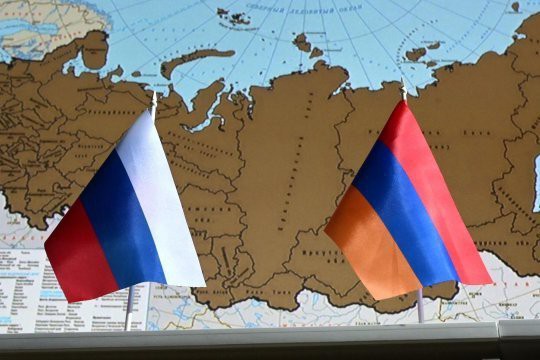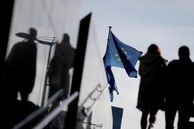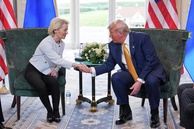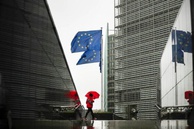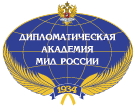During his final news briefing on January 14, [1] the Russian Foreign Minister Sergei Lavrov dwelt, among other things, on the situation in the Trans-Caucasus republics. Interest in this issue means that the situation in the South Caucasus remains a foreign policy priority for Russia.
Sergei Lavrov called on the countries of the region to "resolve all problems with their immediate neighbors" within the framework of the "3+3 mechanism," involving three South Caucasus states - Azerbaijan, Armenia, Georgia and their three neighbors - Russia, Turkey and Iran." He noted, however, that Armenia is participating in dubious geopolitical games, acting as a tool for countries outside the region, thus slowing down the process of peacebuilding in this part of the world. Hence his special attention to this former Soviet republic.
Russia’s top diplomat proceeded by describing the tense relations now existing between the two countries. Lavrov concurred with one of the inquiring journalists in that Armenia is being led down a false, destructive path, which is becoming an obstacle to its very existence. All this is done to sour the centuries-old relations between Russia and Armenia and to please the West.
Fully aware of US and EU interest in the South Caucasus, Yerevan is trying to draw them into resolving regional issues and bargain for their support as a reward for moving away from Russia and actions aimed at phasing it out of the region.
According to Lavrov, Armenia and Azerbaijan are unable to reach peace due to interference by the West, which is trying to impose on these two countries its own solution to the two remaining unresolved issues of the peace treaty.
"The desire of Brussels and Washington to demonstrate that they did it all themselves once again proves that they want to show who is the boss everywhere," Lavrov said. Speaking at a Congressional hearing, US Assistant Secretary of State for European and Eurasian Affairs James O’Brien shed light on the reason why the West insists on providing assistance in clinching a peace deal. When asked what the US can do to demand that Putin withdraw his troops from Armenia, he said, "participate in the conclusion of a peace agreement between Azerbaijan and Armenia." [2]
Sergei Lavrov also emphasized that Russia has never been the initiator of cooling ties with Armenia. In the post-Soviet period, the Russian Federation has repeatedly demonstrated that it does not interfere with the sovereign decisions of neighboring countries and does not intend to impose its dictate on them. The only thing that Moscow wants the authorities of the former Soviet republics to do is not to act irresponsibly in their foreign and domestic policies.
The recent tensions in relations between Russia and Armenia are the result of a number of moves made by Yeravan, which Moscow considers unfriendly and even “anti-Russian.” These include ratification of the Rome Statute of the International Criminal Court, freezing participation in the CSTO, joint military exercises with the United States, and meetings held by representatives of Armenia’s political leadership with representatives of the Kyiv regime.
The start of the year 2025 was marked by two more steps made by the Armenian authorities, aimed at breaking integration ties between the countries of the region. Thus, the government approved a bill launching the process of joining the European Union [3] and signed the Charter on Strategic Partnership with the United States. [4]
Armenia and the European Union
Sergey Lavrov explained in detail why Armenia's membership in the European Union, which Yerevan desires to join, is incompatible with its simultaneous participation in the EAEU. He recalled a statement [5] by Russia’s Deputy Prime Minister Alexey Overchuk, who oversees Eurasian cooperation, about the incompatibility of simultaneous membership in the EAEU and the EU. Moreover, Overchuk emphasized that Russia views the discussion in Armenia of the bill on joining the European Union as the first step towards the country's withdrawal from the EAEU. He warned that if Yerevan breaks off relations with the EAEU, energy and food prices in Armenia will go through the roof and that the export of Armenian goods will plummet by 70-80 percent.
If Armenia changes its course and switches to European gas prices, which are several times higher, the country's economy will tank. The spike in gas prices will inevitably have a negative impact on the cost of goods, utilities and life in general, which will affect every resident of the country. In addition, the republic will lose all customs preferences from Russia and other member countries. The EAEU’s social and humanitarian preferences will no longer apply to citizens of Armenia: These, among others, include recognition of diplomas, medical care, and a simplified system for finding work and studying in the countries of the union.
The inevitability of catastrophic consequences of joining the EU for both the economy of Armenia and the well-being of its people does not mean, of course, that Armenia’s former EAEU partners will wish to punish their ex-member - this will come in keeping with harsh economic reality: "these are two different free trade zones, two different systems for reducing or eliminating duties and tariffs, they do not coincide," Lavrov warned.
Moreover, EU and US also believe that Armenia will find it impossible to be a member of two economic unions. Thus, during a visit to Yerevan, Finland’s parliamentary speaker Eduskunta Jussi Halla-Aho warned [6] that to integrate with the EU, Armenia needs to cancel its membership in the CSTO and the EAEU, and end Russia's military presence in the republic. "In order to further integrate into European structures, Armenia must continue to free itself from dependence on Russia in all areas... Therefore, these two processes - European integration, on the one hand, and leaving Russia's sphere of influence, on the other, must proceed in parallel," Eduskunta Jussi Halla-Aho noted, confirming the harsh realities and goals of the West.
While outlining the main points of the Western policy in Armenia, the US envoy to the OSCE, Daniel Bayer warned [7] that the Armenian people have a "long road" ahead of them to get rid of the "burden of dependence," so "Armenians must be prepared to survive several cold winters." In other words, the US official made no secret of his intention to sacrifice Armenia for the sake of the West’s geopolitical designs in the South Caucasus.
The Armenian leadership is fully aware of the fact that no one in Brussels is waiting for their Trans-Caucasus republic to join in. The experience of Turkey [8], Ukraine and Georgia [9] proves that even if any country’s wish to join the European Union is enshrined in the Constitution, this does not mean that it will actually become an EU member. At the same time, knowing that the so-called “exit from the sphere of Russian influence” will severely undermine the living standards of ordinary citizens of Armenia, the country's leadership is trying to veil these consequences in every possible way. When briefing reporters after the January 21 talks in Moscow, Armenia’s Foreign Minister Ararat Mirzoyan said [10]: “All theorists and practitioners say that there are contradictions there (in combining membership in the EU and the EAEU – A.A.). It is not for me to judge. If the matter comes up, we will probably have to see.” In other words, he found it hard to answer.
When asked about the timing of joining the EU, Mirzoyan said [11] that it had not been determined yet, so there was no point in thinking about the consequences now. Earlier, Armenian Prime Minister Nicol Pashinyan stated [12] that the decision to “enshrine the desire to join the EU” in the country’s Constitution does not mean the country’s membership in the EU, and that this issue can only be agreed in a national referendum. However, analysts believe [13] that “the Armenian prime minister is using the European theme to mobilize his own electorate” for the 2026 parliamentary elections, as well as to legitimize the constitutional changes [14] that Azerbaijan insists on, but civil society does not approve of. They say that this is a tactical concession that will lose its significance after the republic joins the EU.
At the same time, the Armenian authorities are afraid to exit the Eurasian integration structures prematurely, realizing that the resultant socio-economic crisis will undermine the ruling party’s chances to win next year’s election. That is why Nicol Pashinyan is trying to maneuver, since it is impossible to compensate for the loss of investments, business opportunities and military protection ensured by the Russian military contingent deployed in the republic. Well, they may sit on the fence for some time, but at the end of the day they will have to decide which side they are on. Armenia's dual position in relations with the West and the East is undermining the stability of the entire South Caucasus. As for Armenia, the consequences of its joining the European Union are quite predictable.
Example of Ukraine's European integration
During the January 14 press conference Sergei Lavrov reminded the Armenian leadership of Ukraine, which sought to sign an Association Agreement with the EU (AA) in 2013. At that time, Ukrainian President Viktor Yanukovych, trying to curry favor with voters in the western regions, sought to sign the AA, deciding to become a greater European integrator than the opposition. The agreement promised Ukraine practically nothing, but undermined its ties with Russia, the Customs Union (in 2013, Belarus, Kazakhstan and Russia were the basis of the future EAEU) and the CIS. The massive anti-Russian and pro-EU propaganda channeled via all media outlets hushed up the negative aspects (the upcoming closure of most enterprises and mass unemployment, reduction of social programs, etc.) and praised non-existent ones. Uninformed citizens believed that the moment they voted for the AA, the country would be granted full membership in the EU, a visa-free regime and unlimited investments. Moreover, they talked about switching to European standards. What they did not mention, however, was that it was about the TECHNICAL standards of the EU, which only a few enterprises would be able to meet without significant investments, so most of them would inevitably be closed. The people were convinced that it was about the transition to SOCIAL standards of salaries, pensions, scholarships and other social payments.
The main problem was that after joining the free trade area (FTA) with the EU, Ukraine automatically lost its preferences in the FTA with the CIS. The thing is, instead of full trade openness, the European FTA implicated the introduction of import quotas for Ukrainian goods, which also had to meet strict EU requirements for sanitary safety and undergo certification. In keeping with the quotas, Ukraine is allowed to supply goods to European markets in approved very small volumes. In case of exceeding the quotas, Ukraine pays duties to the EU budget, which increases their cost and makes them uncompetitive.
In other words, strict restrictions would be imposed on the export of Ukrainian products to Europe. Simultaneously, customs duties would be imposed on goods from Ukraine in the CIS, just as on imports from the EU, thus rendering them uncompetitive.
Russian experts warned that both Ukraine and Russia needed to protect their economic and trade interests, which were threatened by the European integration planned by Yanukovych. The Ukrainian media presented all these economically sound warnings as “pressure” from Russia, and dubbed Russian experts “horsemen of the Euro-apocalypse.” Pragmatic explanations were simply ignored…
To illustrate the practical consequences of the Association Agreement, in the summer of 2013, Russia introduced corresponding customs restrictions for Ukraine. As a result, in August, the movement of goods on the Russian-Ukrainian border practically ground to a halt, and a weeklong “trade war” broke out. The Russian move did have an effect though. The Ukrainian government began to study the text of the Agreement and by the end of October it had come to disappointing conclusions. Thus, quotas were introduced for Ukrainian goods; Ukraine had to close enterprises that did not meet EU technical standards, and change, at its own expense, the width of the railway track to a narrower one across its entire territory. According to Ukraine’s then Prime Minister Nikolai Azarov, implementing the conditions of the Agreement would require 160 billion euros over 10 years. [15] The EU promised to allocate only about 600 million euros and to petition the IMF for a loan of four billion dollars upon the settlement of Ukraine’s relations with the IMF. At the end of September, Ukraine proposed holding trilateral Ukraine-EU-Customs Union consultations [16], but, according to Lavrov, [17] it faced a flat refusal by the head of the European Commission Jean-Michel Barroso to discuss economic and customs aspects in a trilateral format.
Just ten days before the signing of the AA, the Ukrainian government suspended its preparation, and reiterated its proposal to discuss economic and customs aspects in a trilateral format (Russia agreed, but the EU rejected the idea again.) [18] As a result, the opposition and the Western sponsors behind it used the suspension of the signing of the AA as a pretext for staging a coup - the Maidan.
The example of Ukraine clearly shows the results of reformatting customs borders when the parties are unwilling to resolve contentious issues peacefully. Armenia’s Western curators know full well that due to the weakness of the Armenian economy the country’s break with the EAEU will entail way more serious consequences for it than it did for Ukraine. One may wonder if the dramatic consequences are the result of political antagonism between the EU and Russia. To answer this, we should consider the case of Brexit, a seemingly amicable solution to the UK's exit from the EU.
Brexit: a brief history and consequences of a painful divorce
A referendum on the UK’s membership in the EU was initially considered in a purely hypothetical way. In January 2013, British Prime Minister David Cameron, an opponent of the country's exit from the EU, promised to hold a referendum in order to prevent a split in his own party ahead of the 2015 parliamentary elections. He hoped that in the current political situation at home [19] he would not have to fulfill his promise. Even if a referendum had been necessary, Cameron was confident that the majority of Britons would vote against leaving the EU, as the polls then showed. However, following the 2015 elections, he was still forced [20] to reluctantly fulfill his promise.
The pro-Brexit politicians (led by Boris Johnson) managed to conduct a more effective campaign, during which voters were completely disoriented. Their ideas about the country's real relations with the EU were distorted and public opinion was openly manipulated. For example, they believed that Britain’s contribution to the EU budget was approximately four times bigger than it actually was. They were also convinced that the number of recent immigrants was twice as big as the country’s entire population. [21] According to an Ipsos MORI poll, [22] the Britons believed that EU citizens resident in the country accounted for 15 percent of the population, while the actual figure was only five percent. They were also being fed with wrong stereotypes about the country’s contributions to the EU budget and benefits for migrants, which were inflated several times. In addition, before the referendum, the British were confident that Brexit would not affect their personal wallets. By voting for Brexit, they essentially wanted to retain access to European markets, but not participate in a political union. (Similarities with the situation in Armenia are quite obvious, aren’t they?)
The referendum was a clear example of a choice based not on reliable information, but on PR. On June 23, 2016, the referendum was won by a narrow margin by those who opposed Britain's membership in the EU. Tough negotiations on Britain's exit from the EU followed, which dragged on for several years.
The revision of customs borders by former partners in one EU economic bloc during Brexit led to a serious clash of national interests, which is why negotiations stalled for many years. They almost broke off over the issue of the border between Northern Ireland (part of Great Britain) and the Republic of Ireland (an independent country, part of the EU), which was effectively open before Brexit, since both countries were part of the EU.
The fact is that, according to the agreement on the political settlement of the conflict in Northern Ireland [23] (the Good Friday Agreement, or Belfast Agreement) of 1998, the border was effectively abolished. However, after Brexit, the situation was to change dramatically as the two parts of the island of Ireland would find themselves in different customs and legislative realities, which necessitated the establishment of customs control at the border.
Already during the preparation of the Brexit agreement, the main sticking point was how to avoid the return of a hard 499 km border between Great Britain and the Irish Republic in British Northern Ireland. A series of difficult negotiations resulted in the signing of the Northern Ireland Protocol [24] whereby the customs border was established along the Irish Sea (i.e. British goods were subject to customs restrictions when transported to British sovereign territory - between Northern Ireland and the rest of the kingdom). In practice, the document disrupted intra-British trade in Northern Ireland and effectively created an internal border within the country. In addition, the European Court of Justice effectively supervised a significant part of the protocol on the territory of Northern Ireland, i.e. Great Britain.
The impasse caused a political crisis in Northern Ireland, as the region’s two leading political forces held diametrically different positions regarding the Long-Term Protocol. The loyalists (Protestants) sought to cancel it so that Northern Ireland would remain part of the Kingdom, while Irish nationalists (Catholics) wanted to keep it in place with an eye to eventually uniting Northern Ireland with the Republic of Ireland, which is part of the EU.
In a bid to prevent a resumption of the conflict in the region, which has been going on for more than 30 years between supporters and opponents of Ulster's membership in the United Kingdom, in 2022 the UK government tried to unilaterally revise the Brexit deal with the EU. The European Commission threatened that if London changes the protocol on its own, it will introduce trade barriers for all goods coming to the UK from the single market.
Thus, following the 2016 referendum on the UK’s membership in the EU, the issue of customs borders and procedures has effectively dominated British-Irish (and EU) relations. London and Brussels have been negotiating this for almost nine years now, but it still causes problems, despite the adoption of the “Windsor Framework.” [25]
Since Britain ended its EU membership in January 2024, the country’s economy has already lost £140 billion. These losses are expected to more than double by the middle of the next decade, according to a Cambridge University research. [26]
XXX
According to Russian Deputy Prime Minister Alexey Overchuk, [27] during the next meeting of the EAEU Intergovernmental Council (January 30-31), the members of the Organization will not discuss the issue of Armenia's possible withdrawal from the Eurasian Economic Union amid Yerevan’s current rapprochement with the European Union. He voiced concern [28] about the irresponsibility of some Armenian leaders who "mislead the Armenian people" by claiming that “some solution can supposedly be found."
"The Armenian side knows the consequences absolutely precisely... No one should have any illusions here... Opening markets with the European Union will mean closing markets with the EAEU," Overchuk emphasized. He also reminded that the volume of Armenia's trade with the EAEU countries is several times greater than that of its trade with the European Union. “While trade with the EAEU countries is growing, with the European Union it is declining, which reflects the real state of affairs in the economy better than any words," he noted. I think it would be extremely useful for the Armenian government to calculate the losses from the decision to change economic allies and make them available to the general public before the vote in parliament.
The views of the author are his own and may not reflect the position of the Editorial board.
[1] https://www.mid.ru/ru/press_service/minister_speeches/1991476/
[2] THE FUTURE OF NAGORNO-KARABAKH | Congress.gov | Library of Congress
[3] https://regnum.ru/news/3940360
[4] https://news.am/rus/news/861543.html
[5] https://regnum.ru/news/3940467
[6] https://armenpress.am/ru/article/1210479
[7] https://eadaily.com/ru/news/2024/09/17/a-zima-budet-bolshaya-amerikancy-gotovyatsya-zamorozit-armyan-nazlo-rossii-pabliki
[8] Turkey has been trying unsuccessfully to join the EU for decades, although it is considered an interesting partner for the EU
[9] Georgia’s desire to join EU and NATO in 2017 is enshrined in Article 78 of the country’s Constitution.
[10] https://ria.ru/20250121/lavrov-1994738777.html
[11] https://ria.ru/20250121/lavrov-1994738777.html
[12] https://news.am/rus/news/860685.html
[13] https://regnum.ru/article/3940589
[14] https://vestikavkaza.ru/news/mid-azerbajdzana-napomnil-o-neobhodimosti-izmenenia-konstitucii-armenii.html?ysclid=m6j3rpy1k0413099664
[15] Ukraine needs 160 billion euros to switch to EU standards – Azarov. URL: http://korrespondent.net/ukraine/3205946-ukrayne-dlia-perekhoda-k-standartam-es-nuzhno-160-mlrd-evro-azarov (10.11.2013)
[16] A trilateral format of negotiations between Ukraine, Russia and the EU has not been agreed yet. URL: http://minfin.com.ua/2013/10/08/819552/ (08.10.213); Kyiv proposes a trilateral Ukraine-EU-CU trade format. URL: http://ria.ru/economy/20131025/972606087.html (25.10.2013)
[17] https://www.mid.ru/ru/press_service/minister_speeches/1991476/
[18] EU reminds Russia that signing an association is a bilateral matter. URL: http://www.segodnya.ua/politics/pnews/v-es-napomnili-rosii-chto-podpisanie-associacii-eto-dvuhstoronnee-delo-477238.html (24.11.2013); Barroso rules out talks in a trilateral EU-Ukraine-Russia format. URL: http://korrespondent.net/ukraine/politics/3272857-barrozu-yskluichaet-vozmozhnost-perehovorov-v-formate-es-ukrayna-rossyia (29.11.2013);
[19] The referendum could not be held while the government was a coalition (i.e. before the elections in May 2015), because it included the “pro-European” Liberal Democrats. Moreover, long before the elections, all opinion polls indicated that no party would win a majority. It followed that the government would again be a coalition (with or without the Liberal Democrats), which would free Cameron from his promise. https://interaffairs.ru/jauthor/material/1704
[20] https://interaffairs.ru/news/show/19402
[21] https://london.mid.ru/ru/press-centre/gb_ru_ambarticles_210/
[22] https://www.ipsos-mori.com/researchpublications/researcharchive/3742/The-Perils-of-Perception-and-the-EU.aspx
[23] https://ru.wikipedia.org/wiki/Конфликт_в_Северной_Ирландии
[24] The Northern Ireland Protocol is an agreement on the movement of goods on the island of Ireland between the region of Great Britain - Northern Ireland and the independent Irish Republic, a member of the EU. The Northern Ireland Protocol ensures that the border between Great Britain and the EU (Republic of Ireland) does not become accessible for the smuggling of goods from Great Britain into the EU. This is achieved by physically checking goods coming from Great Britain to Northern Ireland not at the border with the EU - Republic of Ireland, but on their arrival at Northern Irish seaports. Thus, Northern Ireland remains de facto and de jure within the EU customs area.
[25] The Windsor Framework Agreement is the post-Brexit legal agreement between the EU and the UK that governs the Northern Ireland Protocol. The Framework Agreement was announced on 27 February 2023, formally accepted by both parties on 24 March 2023, and came into force on 1 October 2023. The UK Government announced plans to review the Framework Agreement in January 2024.
[27] https://www.interfax.ru/world/1005267
[28] https://www.interfax.ru/russia/1005265
read more in our Telegram-channel https://t.me/The_International_Affairs

 11:35 05.02.2025 •
11:35 05.02.2025 •
